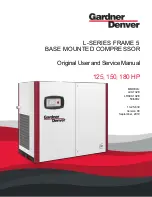
7
© 2015 Emerson Climate Technologies, Inc.
AE4-1365 R4
cycles when the compressor has cooled. This may
cause excessive start-up clearing noise; or the
compressor may start and trip the internal overload
protector several times before running. The addition
of a crankcase heater will reduce customer noise and
dimming light complaints since the compressor will no
longer have to clear out liquid during starting.
Table
4
lists the crankcase heaters recommended for the
various models and voltages. voltages.
WARNING!
Crankcase heaters must be properly grounded.
The heater should be installed on the compressor shell
as shown in
Figure 4
. Ideally the heater would come
together for clamping with the vertical shell seam weld
coming up through the area where the crankcase
heater is clamped together. See
Figure 4
for details.
Tighten the clamp screw carefully, ensuring that the
heater is uniformly tensioned along its entire length
and that the circumference of the heater element is
in complete contact with the compressor shell. It's
important that the clamp screw is torqued to the range
of 20-25 in-lb (2.3-8 N m) to ensure adequate contact
and to prevent heater burnout. Never apply power to
a heater in free air or before the heater is installed on
the compressor to prevent overheating and burnout.
Crankcase Heat - Three Phase
A crankcase heater is
required
for three-phase
compressors when the system charge amount
exceeds the compressor charge limit listed in
Table 3.
Pump Down Cycle
A pump down cycle for control of refrigerant migration is
not recommended for scroll compressors of this size.
If a
pump down cycle is used, a separate discharge line
check valve must be added.
The scroll compressor’s
discharge check valve is designed to stop extended
reverse rotation and prevent high-pressure gas from
leaking rapidly into the low side after shut off.
Minimum Run Time
There is no set answer to how often scroll compressors
can be started and stopped in an hour, since it is
highly dependent on system configuration. Other
than the considerations in the section on
Brief Power
Interruptions
, there is no minimum off time because
Copeland Scroll compressors start unloaded, even
if the system has unbalanced pressures. The most
critical consideration is the minimum run time
required to return oil to the compressor after startup.
To establish the minimum run time, obtain a sample
compressor equipped with a sight tube (available from
Emerson) and install it in a system with the longest
connecting lines that are approved for the system.
The minimum on time becomes the time required
for oil lost during compressor startup to return to the
compressor sump and restore a minimal oil level that
will assure oil pick up through the crankshaft. Cycling
the compressor for a shorter period than this, for
instance to maintain very tight temperature control,
will result in progressive loss of oil and damage to the
compressor. See
AE17-1262
for more information on
preventing compressor short cycling.
Reversing Valves
Since Copeland Scroll compressors have very high
volumetric efficiency, their displacements are lower
than those of comparable capacity reciprocating
compressors.
CAUTION Reversing valve sizing must
be within the guidelines of the valve manufacturer.
Required pressure drop to ensure valve shifting
must be measured throughout the operating range
of the unit and compared to the valve manufacturer's
data. Low ambient heating conditions with low flow
rates and low pressure drop across the valve can
result in a valve not shifting. This can result in a
condition where the compressor appears to be
not pumping (i.e. balanced pressures). It can also
result in elevated compressor sound levels.
During
a defrost cycle, when the reversing valve abruptly
changes the refrigerant flow direction, the suction
and discharge pressures will go outside of the normal
operating envelope. The sound that the compressor
makes during this transition period is normal, and the
duration of the sound will depend on the coil volume,
outdoor ambient, and system charge. The preferred
method of mitigating defrost sound is to shut down the
compressor for 20 to 30 seconds when the reversing
valve changes position going into and coming out of
the defrost cycle. This technique allows the system
pressures to reach equilibrium without the compressor
running. The additional start-stop cycles do not
exceed the compressor design limits, but suction and
discharge tubing design should be evaluated.
The reversing valve solenoid should be wired so
that the valve does not reverse when the system is
shut off by the operating thermostat in the heating
or cooling mode. If the valve is allowed to reverse at
system shutoff, suction and discharge pressures are
reversed to the compressor. This results in pressures
equalizing through the compressor which can cause
the compressor to slowly rotate backwards until the








































